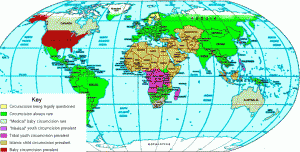By Richard Ammon
 GlobalGayz.com
GlobalGayz.com
March 23, 2011
In 2009 I wrote a blog about male circumcision and HIV in which I doubted the usefulness of removing the male foreskin to prevent or reduce HIV infection. I noted that virtually all Danish men are not circumcised (as I personally observed during the 2nd OutGames in Copenhagen) and yet the HIV incidence rate is very low. (view enlarged map of circumcision prevalence by country)
But African officials in 2008 and 2009 decided differently and urged men to get circumcised to reduce risk of HIV. I said I thought this was a bogus misreading of research and a useless (and painful) procedure that could lead to increased risky sexual behavior (men falsely thinking they were ‘protected’ from HIV).
Today, the following report came out based on more recent research revealing there is no correlation between circumcision and HIV infection:
From: International AIDS Society
http://journals.lww.com/aidsonline/Abstract/2011/02200/Male_circumcision_and_risk_of_HIV_acquisition.14.aspx
20 February 2011
Volume 25 – Issue 4 – p 519–523doi: 10.1097/QAD.0b013e328340fd81
By: Sánchez, Jorgea,c; Sal y Rosas, Victor Gb; Hughes, James Pb; Baeten, Jared Mc; Fuchs, Jonathane; Buchbinder, Susan Pe; Koblin, Beryl Af; Casapia, Martíng; Ortiz, Abnerh; Celum, Connie, et.al.
Circumcision does not have a significant protective effect against HIV
Abstract:
Objectives:
To assess the association between male circumcision, insertive anal sex practices, and HIV acquisition in a cohort of MSM.
Methods:
Data were from 1824 HSV-2-seropositive, HIV-seronegative MSM, 1362 (75%) from Peru and 462 (25%) from the US, who participated in a randomized placebo-controlled trial of HSV-2 suppression for HIV prevention (HPTN 039). Circumcision status was determined by examination at enrollment. HIV testing was done every 3 months for up to 18 months. Partner-specific sexual behavior for up to the last three partners during the previous 3 months was analyzed.
Results:
There was no significant association between male circumcision and HIV acquisition in univariate analysis [relative risk (RR) = 0.84, 95% confidence interval (CI) 0.50–1.42]. In a prespecified multivariate analysis that assumed a linear relationship between the proportion of insertive acts and effect of circumcision on HIV acquisition, the interaction between circumcision and proportion of insertive acts was not significant (P = 0.11). In an exploratory analysis that categorized behavior with recent partners by proportion of insertive acts, circumcision was associated with a nonstatistically significant 69% reduction in the risk of HIV acquisition (RR = 0.31, 95% CI 0.06–1.51) among men who reported at least 60% of insertive acts with recent male partners.
Conclusion:
Circumcision does not have a significant protective effect against HIV acquisition among MSM from Peru and US, although there may be reduced risk for men who are primarily insertive with their male partners. This association needs to be investigated across diverse cohorts of MSM.















